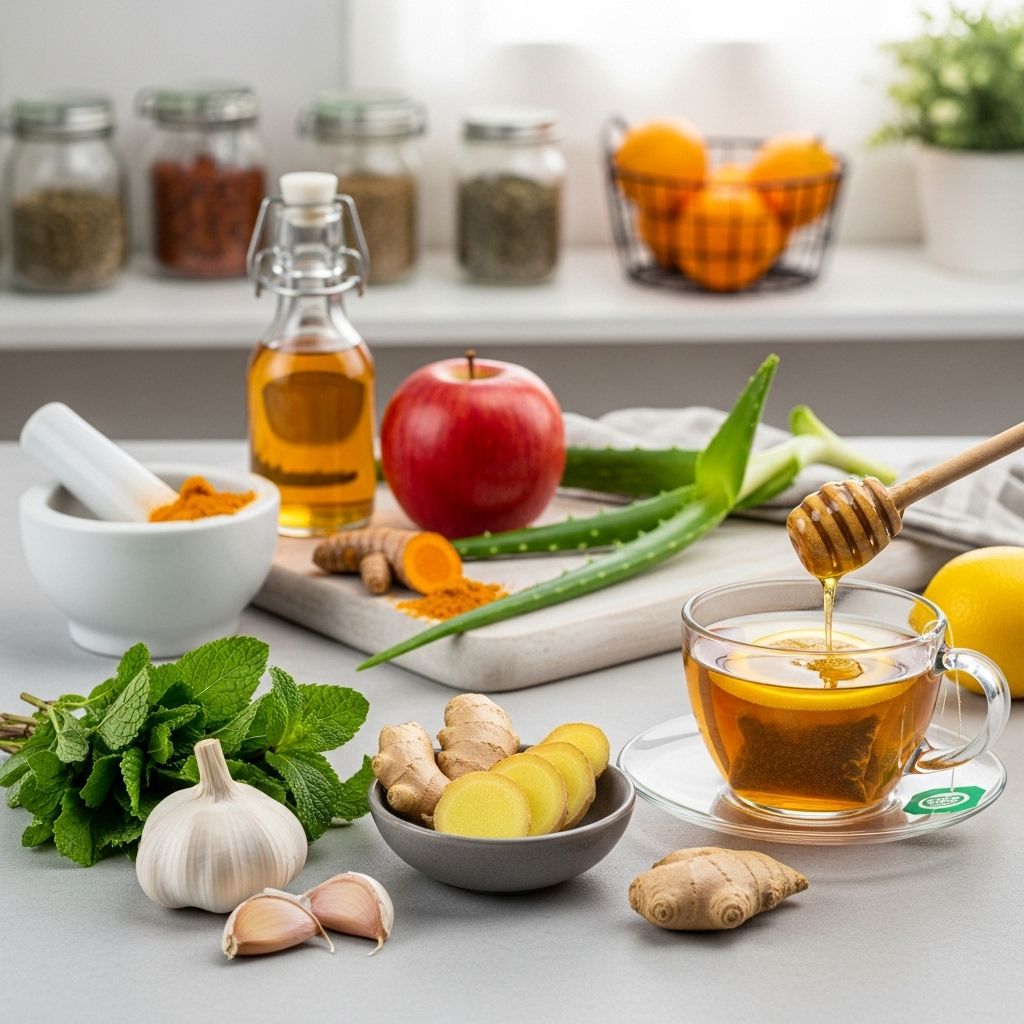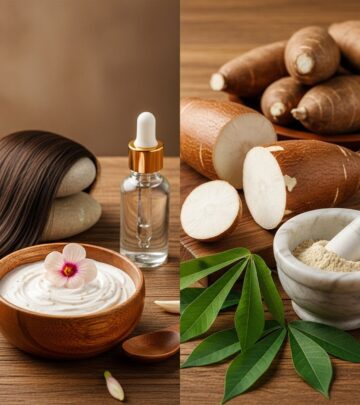Effective Food Home Remedies: Natural Solutions for Common Ailments
Discover science-backed food-based home remedies for everyday health issues and natural relief.

For centuries, people around the world have turned to foods and nature’s bounty to promote wellness and ease everyday health problems. Whether it’s a persisting cough, a stubborn cold, or bothersome indigestion, kitchen staples can often bring quick, safe, and effective relief. This comprehensive guide explores time-tested food-based home remedies, delves into the reasons why they work, and provides practical tips for harnessing the healing power of your pantry.
1. Oatmeal for Relieving Itchy Skin
Oats are more than just a comforting breakfast. Their soothing properties make them excellent for calming irritated or itchy skin caused by conditions like eczema, sunburn, or bug bites.
- How it works: Oats contain compounds called avenanthramides and beta-glucans, which reduce inflammation and create a protective barrier on the skin.
- How to use:
- Grind plain oats into a fine powder and mix with warm (not hot) water to make an oat bath.
- Sit in the bath for 15–20 minutes to relieve itching and redness.
2. Honey for Cough and Sore Throat
Honey is a classic home remedy, appreciated for its soothing consistency and infection-fighting properties.
- How it works: Honey acts as a demulcent, coating the throat and calming irritation. It also possesses antibacterial qualities.
- How to use:
- Take 1–2 teaspoons of raw honey straight or stir into warm herbal tea.
- Do not give honey to children under 1 year old due to the risk of botulism.
3. Ginger for Nausea and Digestion
Long used in traditional medicine, ginger can swiftly ease upset stomach, motion sickness, and indigestion.
- How it works: Gingerol, the primary bioactive compound in ginger, inhibits signals in the gut that trigger nausea and helps food move smoothly through the digestive tract.
- How to use:
- Brewing fresh ginger slices into tea is an effective way to gain its benefits.
- Ginger chews or crystallized ginger can also help with nausea, including morning or motion sickness.
4. Yogurt for Yeast Infections
Yogurt, rich in probiotics, is commonly recommended for restoring healthy bacteria and fighting harmful yeast overgrowth.
- How it works: Live active cultures, particularly Lactobacillus acidophilus, help rebalance vaginal flora and inhibit Candida growth.
- How to use:
- Eat a serving of unsweetened yogurt with live cultures daily to support prevention.
- Topical application may offer localized relief, but consult your doctor before trying this approach.
5. Garlic for Fighting Colds
Garlic is renowned for its antimicrobial and immune-boosting effects. This kitchen staple can be your ally during cold and flu season.
- How it works: Allicin, a sulfur compound released when garlic is chopped or crushed, helps the body combat viruses and bacteria.
- How to use:
- Mince or crush raw garlic and let it sit for a few minutes to activate allicin before adding to food.
- For prevention, incorporate raw or lightly cooked garlic into meals several times per week.
6. Peppermint for Headaches and Muscle Tension
The refreshing scent and cooling properties of peppermint can alleviate headache pain and relax stiff muscles.
- How it works: The menthol in peppermint dilates blood vessels, reduces pain signals, and eases tension.
- How to use:
- Brew peppermint tea or inhale peppermint oil vapor for headache relief.
- Apply diluted peppermint oil to the temples or sore muscles (avoid eyes).
7. Bananas for Heartburn
Bananas are gentle on the stomach and may offer fast relief from acid reflux and heartburn.
- How it works: Bananas coat the lining of the stomach, increase mucus production, and lower stomach acidity, providing a natural buffer against acid.
- How to use:
- Eat a ripe banana when heartburn strikes or as a preventive daily snack.
- Pair with oatmeal for a double-soothing breakfast.
8. Chamomile Tea for Sleep and Calm
Chamomile tea is one of the oldest natural remedies for promoting relaxation, alleviating anxiety, and encouraging restful sleep.
- How it works: Apigenin, a flavonoid in chamomile, binds to receptors in the brain that help reduce nervousness and promote drowsiness.
- How to use:
- Brew 1–2 teaspoons of dried chamomile flowers (or a chamomile tea bag) in hot water.
- Drink 30 minutes before bedtime for best results.
9. Prunes for Constipation Relief
Prunes are a classic natural remedy for occasional constipation, loved by many for their taste and texture as well as their efficacy.
- How it works: Prunes are high in dietary fiber and sorbitol, a natural sugar alcohol that softens stool and stimulates regular bowel movements.
- How to use:
- Consume 3–5 prunes a day, or drink unsweetened prune juice for gentle relief.
- Increase your water intake when eating dried fruits to aid digestion.
10. Turmeric for Inflammation
Turmeric, with its bright golden hue, is celebrated for its anti-inflammatory and antioxidant power, thanks to its active ingredient curcumin.
- How it works: Curcumin interferes with pathways of inflammation and can help manage symptoms in conditions such as arthritis.
- How to use:
- Add a teaspoon of ground turmeric to soups, stews, or smoothies.
- For better absorption, combine turmeric with black pepper and a source of fat (like olive oil).
11. Cranberry Juice for Urinary Tract Health
Cranberry juice is a long-standing remedy for urinary tract infections (UTIs), prized for its ability to help prevent bacteria from adhering to the urinary tract.
- How it works: Proanthocyanidins in cranberries block E. coli bacteria from latching onto the bladder wall.
- How to use:
- Drink 100% unsweetened cranberry juice daily to aid prevention.
- Note: Cranberry can help prevent UTIs but is not a substitute for medical treatment if infection occurs.
12. Apples for Diarrhea
Apples, especially in the form of applesauce, can help firm up stool during a bout of diarrhea.
- How it works: Apples contain soluble fiber (pectin), which absorbs excess fluid and slows bowel movement.
- How to use:
- Eat peeled apples, applesauce, or baked apples for a gentle remedy.
- Avoid apple juice, which can worsen diarrhea in some people due to its high sugar content.
13. Pickle Juice for Muscle Cramps
Athletes and fitness enthusiasts often swear by pickle juice for rapid cramp relief.
- How it works: The sodium and vinegar in pickle juice may help restore electrolyte balance and trigger nerve signals to relax cramped muscles.
- How to use:
- Drink 1–2 ounces of pickle juice during or after physical activity if a cramp occurs.
- Hydrate well with water as well.
14. Carrots for Eye Health
The old adage that carrots are good for your eyes holds some truth. Their beta-carotene content supports vision and overall eye health.
- How it works: Beta-carotene is converted into vitamin A, which is essential for healthy vision and protects against night blindness.
- How to use:
- Enjoy raw, cooked, or juiced carrots as a daily snack or side dish.
Table: Quick-Reference Food Remedies Guide
| Ailment | Remedy Food | Why It Helps |
|---|---|---|
| Itchy Skin | Oatmeal | Soothing, anti-inflammatory properties |
| Cough/Sore Throat | Honey | Coats and calms throat, antibacterial |
| Nausea | Ginger | Helps digestion, reduces nausea signals |
| Yeast Infection | Yogurt | Replenishes good bacteria |
| Colds | Garlic | Antiviral, immune boosting |
| Headache | Peppermint | Relaxes, reduces pain signals |
| Heartburn | Bananas | Stomach lining buffer |
| Sleep issues | Chamomile | Calming, promotes drowsiness |
| Constipation | Prunes | High in fiber and sorbitol |
| Inflammation | Turmeric | Anti-inflammatory curcumin |
| UTI Prevention | Cranberry | Prevents bacterial adhesion |
| Diarrhea | Apples | Absorbs liquid, slows bowels |
| Muscle Cramps | Pickle Juice | Restores electrolytes, triggers relief |
| Eye Health | Carrots | Rich in beta-carotene (vitamin A) |
Frequently Asked Questions (FAQs)
Q: Are food home remedies always safe?
A: Most remedies made from common foods are safe when used as intended. However, some individuals may have allergies or sensitivities. Always consult your healthcare provider if you have a medical condition, are on medication, or if symptoms persist or worsen.
Q: Can these remedies replace medication?
A: Food home remedies are best for mild, short-term issues and are not substitutes for professional medical advice or prescribed treatments. If your condition is serious or does not improve, seek medical care promptly.
Q: Will eating these foods prevent all illnesses?
A: No food can guarantee immunity from illness. A balanced diet supports health, but foods and remedies should be part of a larger healthy lifestyle including sleep, exercise, and good hygiene.
Q: How quickly do food remedies work?
A: Response times vary. Some remedies like honey for a sore throat may provide almost immediate comfort, while others like yogurt for maintaining healthy flora require regular use over time.
Tips for Using Food Home Remedies Safely
- Use fresh, high-quality ingredients where possible.
- Monitor for allergies—start with small amounts of any new food.
- Be wary of remedies for children, pregnant women, or those with chronic health conditions.
- Supplement, don’t replace—view remedies as part of a balanced health strategy.
- If a problem persists more than a few days or is severe, get a professional opinion.
Conclusion
Food home remedies remain a staple in many households for good reason—they are accessible, usually safe, and can alleviate a variety of everyday ailments. While they work best as part of a holistic health routine, these foods and drinks offer comforting and often scientifically-backed support for everything from skin irritation to tummy aches. Explore these remedies to see which work best for you, and always listen to your body—and your healthcare professional—for optimal wellness.
Read full bio of medha deb











